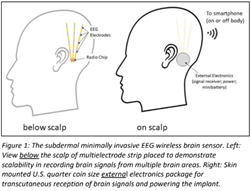Subcutaneous Multi-Channel Wireless EEG For Continuous Home Monitoring
Overview
It is increasingly recognized that for many patients, like those with epilepsy, it can be of paramount importance to record neural activity continuously, 24/7, over weeks and months. Yet, no clinically viable system exists. Currently, the principal diagnostic method for the large Epilepsy patient population (~3 Million in US) is based on short term stays in a hospital. Clinically informative assessment could vastly improve diagnosis and patient care if one could record brain activity continuously for weeks or months outside of clinical settings. This technology is a minimally invasive EEG technology for long term neurological monitoring for home and ambulatory use. The technology is based on an entirely new subdermal wireless sensor concept, an unobtrusive multielectrode strip insertable in a doctor's office yet scalable for recording brain signals from many areas. The device integrates a tiny externally powered radio chip which transmits EEG brain signals through the scalp to a coin size external receiver behind the ear.
Market Opportunity
The diagnosis of epilepsy currently relies on costly short-term hospital stays or 1-3 days of EEG monitoring at home. Existing EEG and related medical devices are cumbersome, tethered to immobile supporting electronics, and limited to short-term neural activity monitoring. A more clinically informative assessment of the disease could be achieved with a minimally invasive, wireless device capable of recording brain activity continuously, 24/7, for weeks or even months. Current devices face several significant limitations: 1) Cannot capture infrequent seizures that occur as rarely as once a week or less. 2) Fail to capture different types of seizures in patients with polymorphic disease due to the lack of long-term monitoring. 3) Unable to record seizures triggered by real-world situations that cannot be simulated in a clinical environment. 4) Struggle to sufficiently track seizures and identify patterns that might reveal triggers or inform therapeutic interventions. 5) Lack capacity to provide data essential for seizure prevention and prediction.
Innovation and Meaningful Advantages
The system is based on an unobtrusive, minimally invasive electronic subdermal implant which does not interfere with a patient’s normal daily activities over weeks, months and beyond. Multiple wireless recording strips can be implanted below the scalp (Fig 1, left image). An external radio receiver/power unit includes a thin minibattery in the behind-the-ear package (Fig 1, right image).

Each standalone 1 millimeter wide, 0.2 millimeter thin, and up to 10 centimeters long polymer strip is an autonomous multielectrode recording unit. The floppy polymer strip can be inserted into the subdermal space by simple incision in a doctor’s office by a thin and flat insertion tool. The strip houses several electrode sites along its length as well as a tiny microelectronic silicon chip integrated onto the strip itself, to collect brain signals from across the temporal lobe, for example. The silicon chip amplifies signals recorded at the electrodes, processes and digitally transmits the captured multichannel data by secure radio-frequency protocol through the scalp. The battery powered external epidermal unit (about the size of U.S. quarter coin) is held behind the ear by a simple adhesive to collect the neural signals from single or several implanted strips while delivering wireless power to the chip. The coin size unit has capability for downstream wireless data transmission to a wearable or remote decryption and data assessment/storage unit. The device concept is unique in being scalable where one or more multiple subdermal strips, inserted from the same millimeter cut to fan out for coverage of a larger brain area, share the scalp-mounted radio receiver.
Collaboration Opportunity: We are interested in exploring research collaborations and licensing opportunities.
References
|
Principal Investigator
Arto Nurmikko, PhD
Professor of Engineering, Professor of Physics
Brown University
arto_nurmikko@brown.edu
https://vivo.brown.edu/display/anurmikk
|
Contact
Melissa Simon, PhD
Director of Business Development
Brown Technology Innovations
melissa_j_simon@brown.edu
Brown Tech ID 3257
|
|